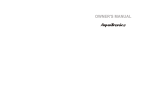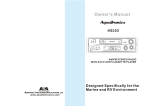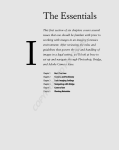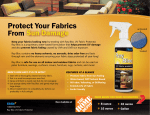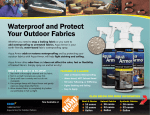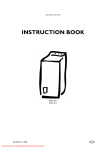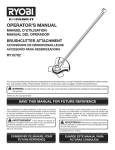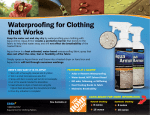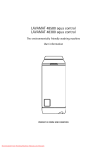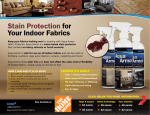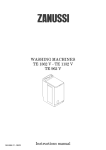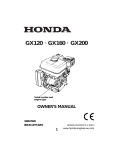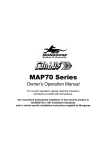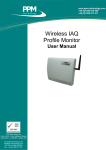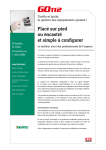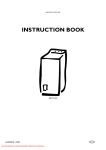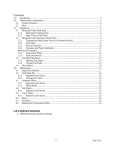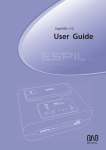Download AIR-SURE LEAK DETECTOR - Retro
Transcript
AIR-SURE LEAK DETECTOR USER MANUAL Welcome Thank you for purchase of the Air-Sure Leak Detector. W e are pleased that you have selected our equipm ent for your m em brane testing needs. 1 Retro-Specs Ltd. Box 69 Grosse Isle, MB R0C 1G0 204-322-5081 rskevinknight@ gm ail.com www.retrospecsltd.com Air-Sure and Retro-Specs are registered in the US Patent and Tradem ark Office and the Canadian Intellectual Property Office. © Retro-Specs Ltd. 1997, 2000, 2005, 2006, 2011. The inform ation contained in Retro-Specs Ltd. user m anuals is believed to be correct at the tim e of printing. Retro-Specs Ltd. reserves the right to change or m odify any inform ation or specifications without notice. The contents of Retro-Specs Ltd. user m anuals are provided “as is.” Except as required by applicable law, no warrantees of any kind, either express or im plied, including, but not lim ited to, the im plied warrantees of m erchantability and fitness for a particular purpose, are m ade in relation to the accuracy, reliability or contents in this m anual. Caution: Changes or m odifications m ade to the Leak Detector that are not expressly approved by Retro-Specs Ltd. will void the user’s authority to operate the equipm ent. 2 Contents Safety and General Information . . . . . . . . . . . . . . . . . . . . . . . . . . . . . . . . . . . . . . . . . . . . . . . . . . . . . . . 4 Introduction to the Air-Sure Leak Detection System . . . . . . . . . . . . . . . . . . . . . . . . . . . . . . . . . . . . . . 6 Getting Started . . . . . . . . . . W hat’s in the Box . . Charging the Battery Battery Use . . . . . . . . . . . . . . . . . . . . . . . . . . . . . . . . . . . . . . . . . . . . . . . . . . . . . . . . . . . . . . . . . . . . . . . . . . . . . . . . . . . . . . . . . . . . . . . . . . . . . . . . . . . . . . . . . . . . . . . . . . . . . . . . . . . . . . . . . . . . . . . . . . . . . . . . . . . . . . . . . . . . . . . . . . . . . . . . . . . . . . . . . . . . . . . Getting to Know Your Air-Sure Leak Detector Hardware Com ponents . . . . . . . . . . . . . . Control Panel . . . . . . . . . . . . . . . . . . . . . . Air-Sure Test Solution . . . . . . . . . . . . . . . . . . . . . . . . . . . . . . . . . . . . . . . . . . . . . . . . . . . . . . . . . . . . . . . . . . . . . . . . . . . . . . . . . . . . . . . . . . . . . . . . . . . . . . . . . . . . . . . . . . . . . . . . . . . . . . . . . . . . . . . . . . . . . . . . . . . . . . . . . . . . . . . . . . . . . . . . . . . . . . . . . . . . . . . 9 . 9 10 11 Using the Air-Sure Leak Detector . . . . . . . . . . . . . . . . . . Cleaning the Area Around the Detail Being Tested Applying Test Solution to the Sam ple Area . . . . . . Placing the Leak Detector Over the Detail . . . . . . Activating the Leak Detector . . . . . . . . . . . . . . . . . Cleaning the Test Area of Residual Test Solution . Optional Accessories . . . . . . . . . . . . . . . . . . . . . . . . . . . . . . . . . . . . . . . . . . . . . . . . . . . . . . . . . . . . . . . . . . . . . . . . . . . . . . . . . . . . . . . . . . . . . . . . . . . . . . . . . . . . . . . . . . . . . . . . . . . . . . . . . . . . . . . . . . . . . . . . . . . . . . . . . . . . . . . . . . . . . . . . . . . . . . . . . . . . . . . . . . . . . . . . . . . . . . . . . . . . . . . . . . . . . . . . . . . . . . . . . . . . . . . . . . . . . . . . . . . . . . . . . . . . . . . . . . . . . . . . . . . 11 12 12 12 13 14 15 Storage and Transportation Storage . . . . . . . . . . . Hoisting . . . . . . . . . . . Transportation by Air . . . . . . . . . . . . . . . . . . . . . . . . . . . . . . . . . . . . . . . . . . . . . . . . . . . . . . . . . . . . . . . . . . . . . . . . . . . . . . . . . . . . . . . . . . . . . . . . . . . . . . . . . . . . . . . . . . . . . . . . . . . . . . . . . . . . . . . . . . . . . 16 16 16 16 . . . . . . . . . . . . . . . . . . . . . . . . . . . . . . . . . . . . . . . . . . . . . . . . . . . . . . . . . . . . . . . . . . . . . . . . . . . . . . . . . . . . . . . . . . . . . . . . . . . . . . . . . . . . . . . . . . . . . . . . . . . . . . . . . . . . . . . . . . . . 7 7 8 8 M aintenance . . . . . . . . . . . . . . . . . . . . . . . . . . . . . . . . . . . . . . . . . . . . . . . . . . . . . . . . . . . . . . . . . . . . . . 17 Maintenance . . . . . . . . . . . . . . . . . . . . . . . . . . . . . . . . . . . . . . . . . . . . . . . . . . . . . . . . . . . . . . . . 17 Cleaning . . . . . . . . . . . . . . . . . . . . . . . . . . . . . . . . . . . . . . . . . . . . . . . . . . . . . . . . . . . . . . . . . . . 17 W arrantee . . . . . . . . . . . . . . . . . . . . . . . . . . . . . . . . . . . . . . . . . . . . . . . . . . . . . . . . . . . . . . . . . . . . . . . . 18 Specifications . . . . . . . . . . . . . . . . . . . . . . . . . . . . . . . . . . . . . . . . . . . . . . . . . . . . . . . . . . . . . . . . . . . . . . 20 3 Safety and General Information IMPORTANT INFORMATION ON SAFE AND EFFICIENT OPERATION OF YOUR AIR-SURE LEAK DETECTOR. DO NOT ATTEMPT TO OPERATE THE LEAK DETECTOR UNTIL YOU HAVE THOROUGHLY READ AND UNDERSTAND ALL OPERATING INSTRUCTIONS AND SAFETY PROCEDURES CONTAINED IN THIS MANUAL. FAILURE TO COMPLY W ITH THESE OPERATING INSTRUCTIONS AND SAFETY PROCEDURES MAY RESULT IN ACCIDENTS INVOLVING FIRE, ELECTRIC SHOCK, AND/OR SERIOUS PERSONAL INJURY. SAVE THIS MANUAL AND REVIEW IT FREQUENTLY FOR CONTINUED SAFE OPERATION. General Use • Use the Leak Detector for the correct purpose. Do not use it for anything other than what it was designed to do. Use only Air-Sure Test Solution with the Leak Detector. Use of an attachm ent not recom m ended by the distributor m ay result in a risk of fire, electric shock, or personal injury. • Never use the Leak Detector in an explosive atm osphere. Norm al sparking of the m otor could ignite flam m able liquid, gases, fum es or dust. Do not place the Leak Detector near fire or extrem e heat. • Use safety glasses when the Leak Detector is in operation. • Do not operate the tool when tired, or while under the influence of drugs, alcohol or m edication. • Keep the work area clean. Cluttered or dirty areas that have been im properly cleaned of residual Test Solution are potential hazards. • Avoid dangerous environm ents. Do not work on wet and/or slippery surfaces. Do not carry the Leak Detector up steep inclines or ladders. Follow the proper hoisting guidelines for your area. • Do not overreach. Keep proper footing and balance at all tim es. Do not use the Leak Detector while on a ladder or on unstable support. Storage and Maintenance • Store the Leak Detector and Test Solution in a dry and secure area - out of reach of children. • Keep the handle and the body of the Leak Detector dry, clean and free from oil and grease. Always use a clean cloth when wiping the Leak Detector. Never use brake fluids, gasoline, petroleum -based products, or any strong solvents for cleaning. • Never open or disassem ble the Leak Detector. • Check dam aged parts. Discontinue using the Leak Detector if any part of the unit appears dam aged. Refrain from further use until the unit is properly repaired or replaced at an authorized service center. Air-Sure Test Solution • Do not use the Air-Sure Test Solution to detect oxygen or other gas leaks. 4 • Do not use the Air-Sure Test Solution on ‘breathable’ m em branes, such as building-wrap. • If the Air-Sure Test Solution com es into contact with the eyes, flush eyes im m ediately with lukewarm water. If irritation persists, contact your doctor. Battery and Charging • Do not operate the Leak Detector while it is being charged. • Use only the battery charger provided with the Leak Detector. Use of another charger m ay dam age the unit, m ay cause serious injury, and will void the warranty. The charger was provided for use only with this Leak Detector. To reduce the risk of injury, do not charge any other batteries, or any other piece of equipm ent, with this battery charger. • Guard against electrical shock by preventing body contact with grounded surfaces while charging the Leak Detector. • To reduce the risk of electric shock, unplug the charger from the power outlet before attem pting to perform any m aintenance or cleaning. Once unplugged, the charger m ay be wiped clean with a clean, dam p cloth and allowed to dry before used again. • If the battery is punctured, and the battery fluid com es into contact with the skin, wash the skin im m ediately with soap and water, and seek m edical attention. If the fluid gets into the eyes, flush eyes im m ediately with lukewarm water for at least ten m inutes, and seek im m ediate m edical attention. Return the dam aged Leak Detector to an authorized service center or to your local distributor. • Do not expose the battery charger to any liquid or frozen liquid. • To reduce the risk of dam age to the charger cord, pull it by the plug when disconnecting the charger. Do not step on the cord, or subject it to dam age or stress. • An extension cord should not be used in conjunction with the charger. Use of an extension cord in this m anner could result in fire or electric shock. • Do not operate the charger with a dam aged cord or plug. If the cord or plug is dam aged, have them replaced im m ediately by a qualified electrician. • Do not operate the charger if it has received a sharp blow, been dropped, or otherwise dam aged in any way. It m ust be replaced. • Do not operate the charger outdoors. • Disconnect the charger from the power supply when not in use. 5 Introduction to the Air-Sure Leak Detection System The Air-Sure Leak Detection System is an effective, efficient and affordable testing system designed to find leaks in single and two-ply m em branes used in all applications. W hen used in conjunction with visual inspection, it provides an accurate reflection of the quality of installation of the m em brane, and will assist in determ ining whether the com pleted system is in adherence with installation specifications and building codes. W hen a test is perform ed, the Air-Sure Leak Detector will indicate whether there are leaks in the test sam ple. It is a sim ple pass/fail test. Areas where the m em brane has been penetrated or dam aged (fasteners and m asonry ties), or where m em brane continuity has been com prom ised (seam s and joints) are just som e of the details which can be tested using the Leak Detector. The Air-Sure Leak Detector allows for the testing of the quality of workm anship quickly, efficiently, and on the job site, with little or no disruption to the critical path of construction. If you have any questions regarding the Air-Sure Leak Detection System , please contact your local distributor. 6 Getting Started What’s in the Box Your Air-Sure Leak Detector com es equipped with a battery already installed, battery charger, Air-Sure Test Solution, and four bottles with daubers. You can purchase other accessory item s and profiles for m axim um perform ance. To purchase other Air-Sure Leak Detector accessories and profiles, contact your local Air-Sure distributor. Charging the Battery New m achines are shipped with batteries partially charged. Before using your Air-Sure Leak Detector, you should charge the battery, using the following instructions. 1. Plug the battery charger into the Leak Detector. The socket is located on the face of the control panel. 7 2. Plug the other end of the charger into the appropriate electrical outlet. 3. A full recharge can be achieved in approxim ately three (3) hours. Although the built-in circuitry will prevent overcharging, it is recom m ended that the charger be disconnected after this tim e. To reduce the risk of dam age to the charger cord, pull it by the plug when disconnecting the charger. Do not step on the cord, or subject it to dam age or stress. Disconnect the charger from the power supply when not in use. As the batteries are sealed lead acid gel batteries, they are not subject to the effects of m em ory, and m ay be charged within any level of charge rem aining. The Air-Sure Leak Detector is designed to achieve approxim ately 130 tests before recharging is required. Charging Care - W hen using the battery charger, adhere to the following safety guidelines: • DO NOT OPERATE THE LEAK DETECTOR W HILE IT IS BEING CHARGED. • The Leak Detector should be charged in a location where the tem perature is between 10°C (50°F) and 40°C (104°F). Do not operate the charger outdoors. • Guard against electrical shock by preventing body contact with grounded surfaces while charging the Leak Detector. • Do not expose the battery charger to any liquid or frozen liquid. • An extension cord should not be used in conjunction with the charger. Use of an extension cord in this m anner could result in fire or electric shock. • Do not operate the charger with a dam aged cord or plug. If the cord or plug is dam aged, have them replaced im m ediately by a qualified electrician. • Do not operate the charger if it has received a sharp blow, been dropped, or otherwise dam aged in any way. It m ust be replaced. • To reduce the risk of electric shock, unplug the charger from the power outlet before attem pting to perform any m aintenance or cleaning. Once unplugged, the charger m ay be wiped clean with a clean, dam p cloth and allowed to dry before used again. Battery Use Do not attem pt to change the battery, or use non-Air-Sure batteries. The Air-Sure warrantee does not cover dam age caused from using non-Air-Sure batteries and/or battery chargers. If the battery is punctured, and the battery fluid com es into contact with the skin, wash the skin im m ediately with soap and water, and seek m edical attention. If the fluid gets into the eyes, flush eyes im m ediately with lukewarm water for at least ten m inutes, and seek im m ediate m edical attention. Return the defective Leak Detector to an authorized service center or to your local distributor. 8 Getting to Know Your Air-Sure Leak Detector Hardware Components The test chamber is the clear, plastic dom e located on the end of the Air-Sure Leak Detector. The black, rubber strip that runs along the bottom of the test cham ber is the cham ber seal. The nose cone is located inside the test cham ber, and is attached to the Leak Detector body. Contained within the nose cone are the pressure switch, and the nose cone light. To rem ove or change the test cham ber, first locate the ring-lock, which surrounds the nose cone, and turn it in a counterclockwise m otion. Once the ring-lock is rem oved, the test cham ber sim ply pulls off. Located within the Leak Detector body are the motor, the battery, and circuitry. The control panel is located on the face of the Leak Detector body. The trigger switch is found on the handle, which is attached to the body. Control Panel It is im portant to be fam iliarized with the control panel before operating the Air-Sure Leak Detector. 9 Auto-M ode Sw itch and Indicator. W hen the Auto-Mode switch is engaged, the pressure differential created by the Leak Detector can increase to a m axim um of 500 Pa. W hen the AutoMode switch is disengaged, the pressure differential created by the Leak Detector can increase to a m axim um of approxim ately 2,500 Pa. W hen the Auto-m ode Indicator is lit, the Auto-m ode switch is engaged. Note: Auto-Mode ‘on’ is the default setting on the Leak Detector. Pressure Indicator. The pressure sensor within the m ain body of the Leak Detector is set to approxim ately 500 Pa (2.0" water). W hen the pressure differential across the test cham ber reaches this level, the Leak Detector will sound an alarm , the Pressure Indicator light will illum inate, and the unit will autom atically shut off indicating the com pletion of the test (provided the Auto-m ode switch is the default ‘on’ position). Battery Pow er Level Indicator. The Battery Power Level Indicator light will rem ain lit when the battery is at the required level for operation. As the battery begins to wear down, the Battery Power Indicator light will flash, indicating that the battery requires recharging. As the battery continues to decrease in energy, the light will begin flashing m ore slowly. Charging Indicator. The Charging Indicator will becom e illum inated when the battery charger is plugged into the Leak Detector, and the battery is receiving a charge. Light Sw itch and Indicator. W hen the Light Switch is turned on, the headlight in the nose cone will be activated. The corresponding Light Indicator on the faceplate will illum inate when the Light Switch is activated. Note: The headlight should be used only to illuminate the test area and is not intended as a replacement for any auxiliary lighting necessary to perform this, or any other, work. Air-Sure Test Solution Use only Air-Sure Test Solution with the Leak Detector. The Air-Sure Test Solution has been specially form ulated such that it will not have any adverse effects upon single-ply waterproofing, roofing, or air barrier m em branes, or on the Leak Detector unit. Do not use the Air-Sure Test Solution on ‘breathable’ m em branes, such as building-wrap, as it will break down the surface tension of m oisture on paper, causing it to pass through the building wrap. Do not use the Air-Sure Test Solution to detect oxygen leaks. If the Air-Sure Test Solution com es into contact with the eyes, flush eyes im m ediately with lukewarm water. If irritation persists, contact your doctor. Before conducting any onsite testing using the Air-Sure Test Solution, check the expiry date on the shipping bottle to ensure that the Test Solution has not passed its expiry date. Even if the expiry date has not been reached, ensure that the Test Solution is still functional before using it for onsite testing. Conduct a ‘test’ using the Air-Sure Leak Detector and Test Solution on a known leak area to ensure that the Test Solution still ‘bubbles’ (see Using the Air-Sure Leak Detector). 10 Using the Air-Sure Leak Detector There are five steps in correctly perform ing a test with the Air-Sure Leak Detector: 1. 2. 3. 4. 5. Clean the area around the detail being tested. Apply Test Solution to the sam ple area. Place the Leak Detector over the detail. Activate the Leak Detector. Clean the test area of residual Test Solution. Cleaning the Area Around the Detail Being Tested Ensure that the test area is free of dirt, dust and debris. The test area should not be hot (from torching), frosted, or extrem ely wet (slight dam pness around the test area will not com prom ise the results of the test). The area being tested should be free of ice, which m ay act to ‘plug’ the leak. Applying Test Solution to the Sample Area Apply the Test Solution to the sam ple area using the dauber included with the 250 m l bottles. W hen applying the Test Solution, ensure the entire sam ple area is covered with a wet film of solution. In the case of a penetration, ensure the entire area is covered. In the case of a seam or joint, ensure that there is solution pushed into the seam or joint. Do not overapply Test Solution (the Test Solution has been overapplied if the Test Solution has form ed a froth or foam over the sam ple area instead of a thin film ). The Air-Sure Test Solution is specially designed to cling to m em branes and m etal details. However, testing of the detail should be conducted im m ediately after application of the solution in order to achieve optim um results. Take care not to spill the Test Solution. Secure the cap back onto the dauber bottle when not in use to avoid spilling Test Solution. 11 Placing the Leak Detector Over the Detail Center the cham ber over the detail, holding the unit firm ly against the m em brane. W hen the seal is in continuous contact with the substrate, the m achine is ready for activation. It is not absolutely necessary to achieve a perfect seal between the test cham ber and the m em brane, as the m achine will adjust for any extraneous leakage that m ay occur. W hen placing the cham ber over the detail, avoid contact between the Test Solution and the cham ber seal. If there is solution under the seal, bubbles m ay form at the seal, producing a false test result. If this occurs, a retest should be perform ed in order to achieve optim um test results. Activating the Leak Detector Once the cham ber has been correctly placed over the test area, the m achine is ready for activation. Begin the test by pulling and holding down the trigger switch located on the handle. The test can be stopped whenever necessary by releasing the trigger switch. When the test is run, if the solution around the test area bubbles, a leak is present. If the solution does not bubble, the detail is airtight. Careful observation is im portant as bubbles of different sizes can form anywhere within the test area where solution is present. Bubbles m ay also form and pop quickly. A very large leak m ay not form a bubble, but rather blow solution away from the detail. This m ay also be caused by lack of solution on the testing area. The m ovem ent of the solution in this fashion usually signifies a leak. However, a retest is advised in this situation. W hen a leak has been identified, the test should be halted im m ediately, letting the pressure within the test cham ber decrease before rem oving the m achine from the detail. The detail can then be m arked for further repair, or the bubble can be photographed if docum entation is required for the particular job. 12 If the test procedure is followed correctly with the m achine in Auto Mode, the unit will autom atically shut off when a pressure differential of 500 Pa (2.0 inches of water colum n) is reached. Record the test results. Note: This does not imply that the workmanship of the detail is to the specifications of the particular job, nor does it imply that the detail in question will not leak at a higher pressure differential. Cleaning the Test Area of Residual Test Solution Although testing has shown that the Test Solution causes no dam age to the m em brane or m etal details, it is essential that all residual test solution be rem oved from all working surfaces once testing has been com pleted. Injury m ay occur by slipping on a surface that has had solution applied to it. W ipe the detail with a clean, dry cloth, to rem ove test solution. W ash area with water and wipe dry. Check the surface by running your hand along the test area. If the test area is slippery to the touch, then repeat the cleaning procedure until the surface is no longer slippery. It is the responsibility of the tester to rem ove all residual Test Solution. Note: Prior to using the Air-Sure Test Solution, ensure that the Test Solution has not passed its expiry date, and is functioning as intended. The solution should be tested on a ‘known’ leak; if the solution does not bubble, it has expired. 13 Notes on Using the Air-Sure Leak Detector. W hen using the Air-Sure Leak Detector, always adhere to the following safety guidelines: • W hen using the Leak Detector, ensure that the pressure reference port, located on the nose cone exterior, rem ains uncovered throughout testing. Be careful not to cover the port with your finger when running the machine. • Use the Leak Detector for the correct purpose. Do not use it for anything other than what it was designed to do. • Always em ploy appropriate safety m easures while using the Leak Detector: use safety glasses when the Leak Detector is in operation, do not operate the Leak Detector when tired, or while under the influence of drugs, alcohol or m edication, and do not use the Leak Detector while on a ladder or on unstable support. • Never use the Leak Detector in an explosive atm osphere. Norm al sparking of the m otor could ignite flam m able liquid, gases, fum es or dust. Do not place the Leak Detector near fire or extrem e heat. • Use of an attachm ent not recom m ended by the distributor m ay result in a risk of fire, electric shock, or personal injury. 14 Optional Accessories There are a variety of other test cham ber profiles that can be used to test specific details and require the hose attachm ent. Each end of the hose fits onto the adapters located on the profile and on the standard dom e. To use the hose attachm ent profiles, place the Leak Detector on a flat surface, such that the standard dom e cham ber has a continuous seal to the surface. Place the hose attachm ent profile over the test area (once Test Solution has been applied to the detail). Run the test as norm al, holding the hose attachm ent profile over the sam ple area. Contact your local distributor for a list of available profiles, or for inform ation on custom profiles. 15 Storage and Transportation In order to keep the Air-Sure Leak Detector in optim al working condition, store the equipm ent when not in use, and use caution when transporting the equipm ent. Follow the guidelines below: Storage If you are storing the equipm ent in the recom m ended Air-Sure Security Case, follow the packing instructions on the case to ensure a stable environm ent for the equipm ent when not in use. If you are not using the Air-Sure Security Case, store the Leak Detector with the test cham ber on the unit. The Leak Detector and the Test Solution should be stored in a dry and secure area - out of reach of children. Hoisting Follow local hoisting and rigging regulations when lifting equipm ent to the test destination. DO NOT lift the equipm ent by carrying it up an unstable incline, ladder or scaffolding. Transportation by Air There are no com ponents inside the Leak Detector which restrict transportation by air. The following is a list of particulars that will aid you in passage through custom s: Batteries are sealed lead acid gel. Serial num ber is located on the side of the m achine body. Country of origin is located on the control panel. The weight of the Leak Detector is approxim ately 15 pounds (6.8 kg). 16 Maintenance Maintenance Check dam aged parts. Discontinue using the Leak Detector if any part of the unit appears dam aged. Refrain from further use until the unit is properly repaired or replaced at an authorized service center. Never open or disassem ble the Leak Detector. Som e parts of the Air-Sure Leak Detector m ay be serviced without bringing the unit to the distributor’s service depot: C Burned out light bulb in the nose cone: replace with a 6.3V 0.15A (size T-3¼) incandescent light bulb. Unscrew the lens cover counterclockwise to rem ove. Once the lens cover has been rem oved, unscrew light bulb counterclockwise. Replace bulb. Screw lens cover, clockwise, back onto the Leak Detector For problem s that are not listed above, contact your local distributor. Cleaning W ipe the casing and cham ber of the Leak Detector with a clean cloth. For best results, use a furniture polish on the casing. NEVER use gasoline, other petroleum -based products, or any solvent for cleaning the Leak detector. 17 Retro-Specs Limited Warrantee for the United States and Canada What Does this Warrantee Cover? Subject to the exclusions contained below, Retro-Specs Ltd. warrants its leak detection equipm ent to be free from defects in m aterials and workm anship under norm al consum er usage for the period(s) outlined below. This lim ited warrantee is a consum er’s exclusive rem edy, and applies as follows to new Air-Sure Products and Accessories purchased by consum ers in the United States or Canada, which are accom panied by this written warrantee: Products and Accessories Products Covered Length of Coverage Products and Accessories as defined above. One (1) year from the date of purchase by the first consumer purchaser pf the product. Exclusions Normal W ear and Tear. Periodic m aintenance, repair and replacem ent of parts due to norm al wear and tear are excluded from coverage. Batteries. Only batteries whose fully charged capacity falls below 80% of their rated capacity and batteries that leak are covered by this lim ited warrantee. Abuse & M isuse. Defects or dam age that result from : (a) im proper operation, storage, m isuse or abuse, accident or neglect, such as physical dam age (cracks, scratches, etc.) to the surface of the product resulting from m isuse; (b) contact with liquid, water, rain, extrem e hum idity or heavy perspiration, sand, dirt or the like, extrem e heat, or food; (c) use of the Products or Accessories for com m ercial purposes or subjecting the Product or Accessory to abnorm al usage or conditions; or (d) other acts which are not the fault of Retro-Specs, are excluded from coverage. Use of Non-Air-Sure Products and Accessories. Defects or dam ages that result from the use of NonAir-Sure branded or certified Products, Accessories, Electronics or other peripheral equipm ent are excluded from coverage. Unauthorized Service or M odification. Defects or dam ages resulting from service, testing, adjusting, installation, m aintenance, alteration, or m odification in any way by som eone other than Retro-Specs, or its authorized service centers, are excluded from coverage. Altered Products. Products or Accessories with (a) serial num bers or date tags that have been rem oved, altered or obliterated; (b) broken seals or that show evidence of tam pering; (c) m ism atched board serial num bers; or (d) nonconform ing or non-Air-Sure housings, or parts, are excluded from coverage. Who is Covered? This warrantee extends only to the first consum er purchaser, and is not transferrable. 18 What Will Retro-Specs do? Retro-Specs, at its option, will at no charge repair, replace or refund the purchase price of any Products or Accessories that does not conform to this warrantee. W e m ay use functionally equivalent reconditioned/refurbished/pre-owned or new Products or Accessories. How to Obtain Warrantee Service or Other Information? Contact your local distributor. You will receive inform ation on how to ship the Products or Accessories, at your expense, to an Air-Sure authorized repair center. To obtain service, you m ust include: (a) a copy of your receipt, bill of sale or other com parable proof of purchase; (b) a written description of the problem ; and (c) your address and telephone num ber. What Other Limitations Are There? ANY IMPLIES W ARRANTEES, INCLUDING W ITHOUT LIMITATION THE IMPLIED W ARRANTEES OF MERCHANTABILITY AND FITNESS FOR A PARTICULAR PURPOSE, SHALL BE LIMITED TO THE DURATION OF THIS W ARRANTEE, OTHERW ISE THE REPAIR, REPLACEMENT, OR REFUND AS PROVIDED UNDER THIS EXPRESS LIMITED W ARRANTEE IS THE EXCLUSIVE REMEDY OF THE CONSUMER, AND IS PROVIDED IN LIEU OF ALL OTHER W ARRANTEES, EXPRESS OR IMPLIED. IN NO EVENT SHALL RETRO-SPECS BE LIABLE, W HETHER IN CONTRACT OR TORT (INCLUDING NEGLIGENCE) FOR DAMAGES IN EXCESS OF THE PURCHASE PRICE OF THE PRODUCT OR ACCESSORY, OR FOR ANY INDIRECT, INCIDENTAL, SPECIAL OR CONSEQUENTIAL DAMAGES OF ANY KIND, OR LOSS OF REVENUE OR PROFITS, LOSS OF BUSINESS, OR OTHER FINANCIAL LOSS ARISING OUT OF OR IN CONNECTION W ITH THE ABILITY OR INABILITY TO USE THE PRODUCTS OR ACCESSORIES TO THE FULL EXTENT THESE DAMAGES MAY BE DISCLAIMED BY LAW . 19 Air-Sure Leak Detector Specifications 1. GENERAL DESCRIPTION. Primarily intended as a tool to locate leaks in single-ply and two-ply membrane systems, including but not limited to: air barriers, vapor barriers, roofing systems, waterproofing and ground liners. Can be utilized during construction (prescriptive testing) and post-construction. For commercial, industrial, institutional and residential applications. COMPOSITION AND MATERIALS. Air-Sure Leak Detector body is comprised of powder-coated steel. The test chamber is durable poly-carbonate, with a closed-cell, neoprene rubber seal. Material Safety Data Sheets (MSDS) for the Air-Sure Test Solution are available from your local distributor upon request. DIMENSIONS. Leak Detector body: 20.0 in. x 6.5 in. x 6.5 in. 28.0 in. x 17.0 in. x 17.0 in. (with Standard Dome Profile attached) 14.0 pounds (6.4 kg) POWER SUPPLY. One (1) 12V sealed lead acid gel battery (rechargeable). ACCESSORIES. Air-Sure Leak Detector comes complete with Standard Dome Profile, 4L Air-Sure Test Solution (with four (4) 250 mL dauber bottles), Battery Charger, and Operator’s Manual. 2. TECHNICAL DATA APPLICABLE STANDARDS. Test method is in keeping with ASTM E 1186-98 “Standard Practices for Air Leakage Site Detection in Building Envelopes and Air Retarder Systems” method 4.2.7 Chamber Depressurization in Conjunction with Leak Detection Liquid). MATERIAL CONSIDERATIONS. Testing using the Air-Sure Leak Detector (in conjunction with Air-Sure Test Solution) will not damage the membrane system when the equipment is used as intended. Air-Sure Test Solution should not be applied to plastic resin building wraps. 3. USE PREPARATORY WORK. The sample area selected should be wiped clean of dirt, grit, dust or debris. Test area should not be hot (from torching), frosted, extremely wet, and should be free of ice. Testing can be performed on seams, joints, and penetrations in the membrane. 20 METHOD. Air-Sure Test Solution is applied liberally to the area being tested. The test chamber is placed over the sample area, and the Leak Detector activated. Contact between the Test Solution and test chamber should be avoided. Bubbles in the Test Solution indicate the presence of a possible leak. 4. AVAILABILITY AND COST AVAILABILITY. Air-Sure Leak Detector is available worldwide, usually shipped from stock. Contact Retro-Specs Ltd. for a list of distributors. COST. Current price list available from local distributor. 5. W ARRANTEE The information contained herein is the best available relating to the Air-Sure Leak Detector, and the recommendations contained herein are based upon information believed to be reliable. Limited warrantee covers all parts and labor costs resulting from defects in materials or workmanship for a period of one (1) year. 6. M AINTENANCE CLEANING. Test chamber and machine casing should be wiped clean with a damp cloth. Furniture polish may be used on the machine casing. Do not use gasoline, petroleum-based products or solvents on the Air-Sure Leak Detector. CHARGING. Air-Sure Leak Detector is designed to perform approximately 100 tests before recharging if the battery is required. A full recharge can be achieved in approximately three (3) hours. Although the built-in circuitry will prevent overcharging, it is recommended that the charger be disconnected after this time. LIGHT BULB. Nose cone light bulb is a 6.3V 0.15 (size T-3¼) incandescent light bulb. 7. TECHNICAL SERVICES Technical support is available from Retro-Specs Ltd. Call 204.322.5081. Specification assistance. Site advice and recommendations. 8. RELATED REFERENCES ASTM E 1186-02 PWGSC National Master Specification Section 07271 Air Barriers (Descriptive/Proprietary) Section 07272 Air Barriers (Performance) Canada Mortgage and Housing Corporation Guidelines for Delivering Effective Air Barrier Systems ASTM STP 1422 A New Protocol for the Inspection and Testing of Building Envelope Air Barrier Systems 21






















